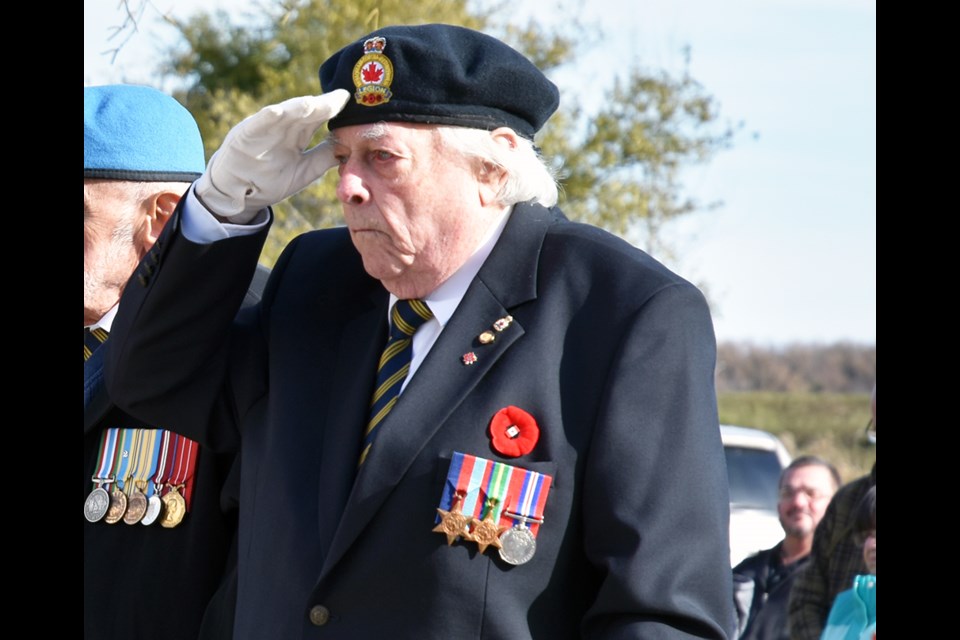Les Buxton grew up in Nottingham, England. He turned 18 in 1943, at the height of the Second World War.
Buxton was immediately conscripted into the Royal Navy. He had become an apprentice toolmaker after leaving school, and in the Navy passed a trade test that allowed him to become an engine room artificer — a marine engineering technician, helping to maintain the engine room equipment.
As Buxton put it: “I’m the one paddling through the hole in the bottom of the boat!”
He hadn’t exactly planned to join the Navy.
“I remember in high school, we had to write an essay on what we wanted to do when we grew up,” he said. “I didn’t want to work in a dirty factory, or sit in an office, or serve on a ship, where there were no girls.”
He served aboard a Navy Destroyer, at first stationed in the British Isles, then standing by off the coast of France on D-Day.
The crew were assigned 36-hour action stations during that hectic time.
“It’s the only time I think I fell asleep standing up,” Buxton said. Leaning back against two pipes that provided just the right amount of support, he fell asleep for about 20 minutes — but he never left his post.
After D-Day, Buxton’s ship spent the next year making its way from the Atlantic Ocean to the Pacific Ocean.
“We took a convoy to Malta. Of course, it was getting pretty quiet by that time,” he said. The ship then made its way through the Suez Canal to Sri Lanka in the Indian Ocean, where it served as a base for attacks on the oil installations in Sumatra.
The destroyer continued eastward to the Pacific, where war was still raging with Japan. They stopped at Eniwetok Atoll in the Marshall Islands, taken by American forces in 1944.
“We just got back from Eniwetok when the atomic bombs blew everything apart,” said Buxton. During the next 15 months, Buxton and the rest of the crew were involved in occupation duties in Japan and Hong Kong, with a quick trip to Korea to set up the British Embassy there.
In Japan, he toured the bombed-out areas of Hiroshima and Nagasaki, including the Mitsubishi torpedo works.
“At least the ruins of it,” said Buxton. “I thought to myself at the time, ‘If not for the atomic bomb, one of those torpedoes might have had my name on it.’”
Buxton returned to Britain in 1946 and was discharged from the Navy in January 1947. He emigrated in 1953 to Canada, where he met his wife Madge, also from Britain, through a mutual friend.
A civil engineer, Buxton worked for the Toronto Transit Commission as chief structural engineer.
He retired 30 years ago and now lives in Bradford West Gwillimbury, where he is best known as a talented artist and leader of the Varga Group of Artists, who meet at the Danube Seniors Leisure Centre.
He has always been interested in art. In school, he was taught to paint in watercolour but wanted to paint in oils, and so he mixed olive oil with his watercolour pigments.
“I thought it was wonderful, but I got hell from my teacher,” Buxton remembered. “It was a muddy mess!”
He continued his art while in the Royal Navy. “I did some sketching while I was overseas,” he said. “I sent the sketches home to my mother.” The sketches haven’t been preserved.
It wasn’t until the 1950s that he returned to painting. “I was too busy,” Buxton said.
He now paints in watercolour, acrylic and oils, often from photos taken on his travels since retiring.
Buxton knows that many people oppose the use of atomic bombs on Japan during the war. He said he does not because the atom bomb brought an end to a bloody war and continued loss of life — but, he added, “I hope we never use them again.”


